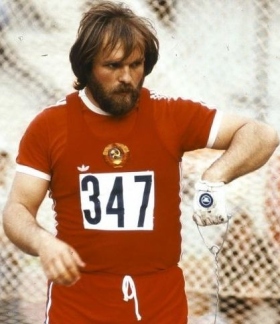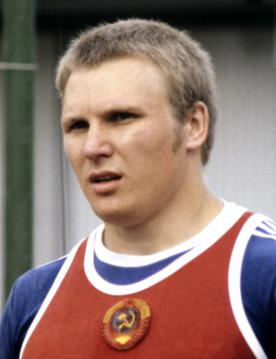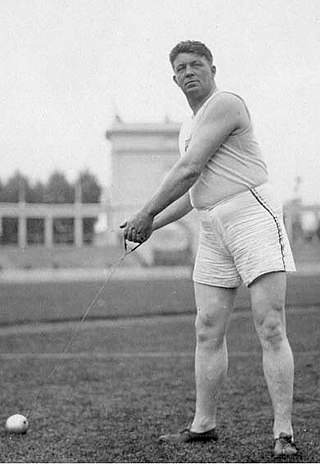
Yuriy Georgiyevich Sedykh was a track and field athlete who represented the Soviet Union from 1976 to 1991 in the hammer throw. He was a European, World and Olympic Champion, and holds the world record with a throw of 86.74 m in 1986.

Sergey Nikolaevich Litvinov was a Russian hammer thrower and athletics coach. He competed at the 1980 Summer Olympics and the 1988 Summer Olympics, missing the 1984 Summer Olympics due to the Soviet boycott, and won a silver and a gold medal, respectively. He also won two world titles, in 1983 and 1987. After retiring from competitions he coached elite hammer throwers including Ivan Tsikhan and his son Sergey.
The men's discus throw was an event at the 1996 Summer Olympics in Atlanta, Georgia. There were 40 competitors from 30 nations. The maximum number of athletes per nation had been set at 3 since the 1930 Olympic Congress. The final was held on July 31, 1996. The event was won by Lars Riedel of Germany, the nation's first victory in the men's discus throw. Belarus won two medals in its debut, with Vladimir Dubrovshchik earning silver and Vasiliy Kaptyukh taking bronze.

The men's hammer throw was an event at the 1996 Summer Olympics in Atlanta, Georgia. There were 37 competitors from 22 nations, with twelve athletes reaching the final. The maximum number of athletes per nation had been set at 3 since the 1930 Olympic Congress. The eight highest-ranked competitors after three rounds qualified for the final three throws to decide the medals. The qualification mark was set at 76.50 metres. The event was won by Balázs Kiss of Hungary, the nation's first victory in the men's hammer throw since 1968 and fourth overall. Lance Deal earned the United States' first medal in the event since 1956 with his silver. Oleksandr Krykun's bronze gave Ukraine a medal in its debut as an independent nation.

The men's hammer throw event was part of the track and field athletics programme at the 1920 Summer Olympics. The competition was held on Wednesday, August 18, 1920. 12 throwers from 5 nations competed; four from Sweden, four from the United States, two from Canada, one from Great Britain, and one from Finland. No nation had more than 4 athletes, suggesting the limit had been reduced from the 12 maximum in force in 1908 and 1912. The event was won by Patrick Ryan of the United States, the nation's fifth consecutive victory in the event. Carl Johan Lind took silver, earning Sweden's first medal in the hammer throw. Another American, Basil Bennett, earned bronze.

The men's hammer throw was an event at the 1992 Summer Olympics in Barcelona, Spain. There were 27 participating athletes from 19 nations. The maximum number of athletes per nation had been set at 3 since the 1930 Olympic Congress.
The men's shot put was an event at the 1992 Summer Olympics in Barcelona, Spain. There were 26 participating athletes from 18 nations. The maximum number of athletes per nation had been set at 3 since the 1930 Olympic Congress. The event took place on 31 July 1992. The event was won by Mike Stulce of the United States, the nation's first victory in the men's shot put since 1968. His countryman Jim Doehring took silver. Vyacheslav Lykho of the Unified Team earned bronze, the first medal for a Soviet or former Soviet athlete in the event since 1980.

The men's hammer throw at the 1988 Summer Olympics in Seoul, South Korea had an entry list of 30 competitors from 16 nations, with two qualifying groups before the final (12) took place on Monday September 26, 1988. The maximum number of athletes per nation had been set at 3 since the 1930 Olympic Congress. In the final round the eight highest-ranked competitors after three rounds qualified for the final three throws to decide the medals. The event was won by Sergey Litvinov of the Soviet Union, the nation's sixth victory in the event. The Soviet team completed the medal sweep, with Yuriy Sedykh taking silver and Jüri Tamm bronze. It was the Soviets' third medal sweep in four Games, with only the boycotted 1984 Games missing. The 1988 team was the same as the 1980 squad, with Litvinov and Sedykh trading places. Litvinov and Tamm were the ninth and tenth men to earn multiple medals in the hammer throw, while Sedykh became the fourth to win three medals; his two golds and a silver trailed only John Flanagan's three gold medals in Olympic success.
The men's discus throw event at the 1988 Summer Olympics in Seoul, South Korea had an entry list of 29 competitors from 20 nations, with two qualifying groups before the final (12) took place on Saturday October 1, 1988. The maximum number of athletes per nation had been set at 3 since the 1930 Olympic Congress. The event was won by Jürgen Schult of East Germany, the nation's first victory in the men's discus throw and first medal since 1976. Romas Ubartas of the Soviet Union took silver, while Rolf Danneberg of West Germany earned bronze. Danneberg was the 10th man to win multiple discus throw medals, adding to his 1984 gold. For the first time, the United States competed in the event but did not make the podium.
The men's discus throw at the 1984 Summer Olympics in Los Angeles, California had an entry list of 20 competitors from 14 nations, with two qualifying groups before the final (12) took place on August 10, 1984. The maximum number of athletes per nation had been set at 3 since the 1930 Olympic Congress. The event was won by Rolf Danneberg of West Germany, the nation's first medal in the men's discus throw and the first victory by any German athlete in the event. Mac Wilkins and John Powell of the United States won silver and bronze; they were the eighth and ninth men to win multiple discus throw medals. The United States continued its 19-Games streak of earning at least one medal every time it appeared, missing the podium only in the boycotted 1980 Games; however, this would be the last Games in that streak—and, in fact, the last medals the United States would earn in the event through at least 2020.
The men's discus throw event at the 1980 Summer Olympics in Moscow, Soviet Union had an entry list of 18 competitors from 12 nations, with one qualifying group and the final (12) held on Monday July 28, 1980. The maximum number of athletes per nation had been set at 3 since the 1930 Olympic Congress. The event was won by Viktor Rashchupkin of the Soviet Union, the nation's first medal and first victory in the men's discus throw. Imrich Bugár put Czechoslovakia back on the podium in the event after a one-Games absence, taking silver. Luis Delís earned Cuba's first men's discus throw medal with his bronze. The United States, which had earned at least one medal in every appearance of the event prior to 1980, missed the podium due to the boycott.

The men's hammer throw event at the 1980 Summer Olympics in Moscow, Soviet Union had an entry list of 17 competitors from 13 nations, with one qualifying group before the final (12) took place on 31 July 1980. Top 12 and ties and all those reaching 72.00 metres advanced to the final. The maximum number of athletes per nation had been set at 3 since the 1930 Olympic Congress. The event was won by Yuriy Sedykh of the Soviet Union, repeating as Olympic champion. He was the eighth man to win multiple medals in the event and third to have at least two gold medals. Just as in 1976, Sedykh led the Soviet team to a medal sweep, with Sergey Litvinov taking silver and Jüri Tamm bronze. The gold medal was the Soviet Union's third consecutive and fifth overall in the men's hammer throw, second all-time to the United States's seven.
The men's shot put event at the 1980 Summer Olympics in Moscow, Soviet Union had an entry list of 16 competitors from 11 nations. The maximum number of athletes per nation had been set at 3 since the 1930 Olympic Congress. The final was held on Wednesday 30 July 1980, with the qualifying round staged two days earlier in the Lenin Stadium. The top twelve and ties, and all those reaching 19.60 metres advanced to the final. The event was won by Vladimir Kiselyov of the Soviet Union, the nation's first victory in the men's shot put. The Soviet Union became only the third nation to reach the podium in consecutive Games in the event, as East Germany became the second to reach a three-Games streak on the podium as Udo Beyer took bronze. Beyer and Aleksandr Baryshnikov became the ninth and tenth men to win multiple medals in the shot put.
The men's shot put event at the 1984 Summer Olympics in Los Angeles, United States had an entry list of 19 competitors from 13 nations. The maximum number of athletes per nation had been set at 3 since the 1930 Olympic Congress. The final was held on August 11, 1984. The event was won by Alessandro Andrei of Italy, the nation's first medal in the men's shot put. Michael Carter and Dave Laut of the United States took silver and bronze, respectively, putting Americans back on the podium for the first time since 1972.

The men's hammer throw at the 2000 Summer Olympics as part of the athletics program was held at the ANZ Stadium on Saturday, 23 September and Sunday, 24 September. There were 44 competitors from 24 nations. The event was won by Szymon Ziółkowski of Poland, the nation's first victory in the event and first medal of any color in the men's hammer throw since 1960. Silver went to Nicola Vizzoni, the first medal winner in the event for Italy. Igor Astapkovich, who had won a silver medal on the Unified Team in 1992, took bronze for the first medal credited to Belarus in the event. Astapkovich was the 11th man to win multiple medals in the hammer throw.

The men's hammer throw event was part of the track and field athletics programme at the 1936 Summer Olympics. The competition was held on August 3, 1936. There were 27 competitors from 16 nations. The maximum number of athletes per nation had been set at 3 since the 1930 Olympic Congress. The final was won by Karl Hein of Germany. The silver medal went to Erwin Blask, also of Germany. They were the first medals for Germany in the event; Germany was also the first country other than the United States to have two medalists in the event in the same Games. Fred Warngård of Sweden took bronze. The United States' eight-Games medal streak in the hammer throw was snapped, with the Americans' best result being William Rowe's fifth place.

The men's discus throw was a competition at the 2012 Summer Olympics in London, United Kingdom. The event was held at the Olympic Stadium on 6–7 August. Forty-one athletes from 24 nations competed. The event was won by Robert Harting of Germany, the nation's first victory in the men's discus throw since 1996 and second overall. Ehsan Haddadi earned Iran's first medal in the event with his silver. Gerd Kanter of Estonia became the 15th man to win multiple medals in the event, adding a bronze to his 2008 gold. Virgilijus Alekna of Lithuania narrowly missed being the second man to win four medals in the event, finishing fourth.

The men's hammer throw event at the 1952 Summer Olympics took place on 24 July at the Helsinki Olympic Stadium. There were 33 competitors from 18 nations. The maximum number of athletes per nation had been set at 3 since the 1930 Olympic Congress. The event was won by József Csermák of Hungary, the nation's second consecutive victory in the event. Imre Németh, who had won four years earlier, took bronze; he was the fourth man to win multiple medals in the event. Silver went to Karl Storch of Germany.

The men's hammer throw competition at the 1976 Summer Olympics in Montreal, Quebec, Canada took place on 26–28 July. There were 20 competitors from 13 nations. The maximum number of athletes per nation had been set at 3 since the 1930 Olympic Congress. The event was won by Yuriy Sedykh of the Soviet Union, the nation's second consecutive and fourth overall victory in the men's hammer throw. The Soviets swept the medals, with Aleksey Spiridonov taking silver and defending champion Anatoliy Bondarchuk earning bronze. It was the third medal sweep in the men's hammer throw. Bondarchuk was the seventh man to win multiple medals in the event.
Scott Neilson is a Canadian former track and field athlete who competed in the hammer throw. His personal best was 72.72 m, set in Seattle on 1 April 1978.











